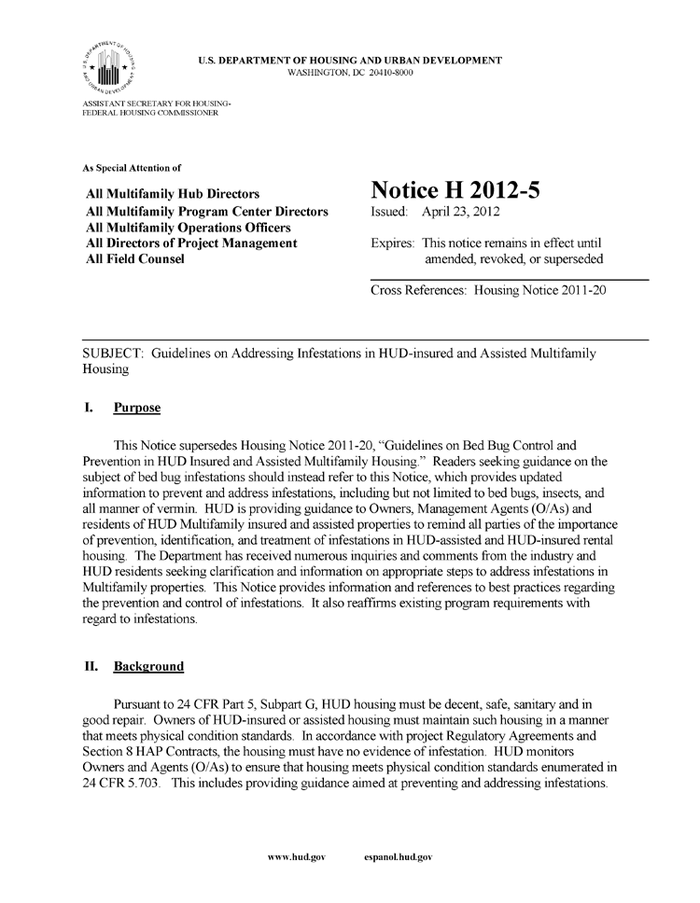Hud Bed Bug Policy 2019
The phrase “Don’t let the bed bugs bite” is mostly used in a lighthearted and joyous way, but bed bugs are a real concern. Bedbugs continue to raise their filthy little heads in all kinds of properties, from luxury lodges to affordable accommodations. Affordable housing supervisors are always concerned regarding what they can and can’t expect residents regarding bed bug treatments. Affordable housing developments without particular central management regulations should usually follow state regulation and the requirements of firms providing funding. For instance, LIHTC (Low-Income Housing Tax Credit) properties would follow the guidelines of the Housing Finance Agency that bestowed the credits, along with the state tenant/landlord laws. However, properties with direct HUD assistance, like project-based Section 8 properties, have HUD guidelines that must be followed.
New HUD Bed Bug Guidance
The primary HUD guidance regarding the bed bugs is found in HUD Notice H2012-5. The Notice backed away from the prior position of HUD that strictly restrained both charging tenants for damage associated with bed bugs and the termination of possession of non-compliant tenants. The HUD’s Notice H 2012-5 stated, “All owners (of assisted and unassisted properties) may pursue remedies provided in the lease agreement and accordance with state and local rental law. Assisted owners must follow additional guidelines including occupancy requirements for assisted housing and must adhere to all HUD and state and local landlord/tenant laws before taking action to deny tenancy or remove residents for causes related to infestations.”
HUD does not especially prohibit landlords from charging residents for bed bug extermination, but the method must be described in various documents like the TSP (Tenant Selection Plan), IPM (Integrated Pest Management) Plans, and house rules. In early 2019, HUD issued a notice, “Clarification to Housing Notice H 2012-5 Guidelines on Addressing Infestations in HUD Insured and Assisted Multifamily Housing”, clarifying items in which HUD stressed the following:
- Any postscript to the HUD Model Lease needs HUD approval. As the lease needs the owner to provide certain extermination assistance, lease language shifting the expense to the resident will be disproved, unless the landlord can show that the bed bug infestation was caused by negligence or carelessness on the part of the tenant.
- While accommodation rules do not need HUD permission, placing the inspection burden on tenants would not be considered a tolerable rule unless the authority has an institutional program to help tenants recognize and understand the significance of prevention and reporting.
Final Words
Based on the HUD Notice H2012-5 guidance, owners/agents should not establish policies claiming that tenants bear the expense of bed bug eradication. However, tenants may be asked to cover expenses associated with bedbug infestation if they decline to cooperate with an IPM Plan or interfere with or fail to allow necessary inspections and procedures.
Hud Bed Bug Policy 2019
Hud is committed to providing you with the best quality products available. However, we recognize that from time to time there may be some minor issues with our products. Hud is therefore offering a bed bug policy that will allow any customer who has purchased a product from us in the last two years to return it for a full refund if they find it has been infested with bed bugs.
The policy covers all of our electronic devices, clothing and furniture. If you discover that your device or piece of furniture has been infested with bed bugs, please contact Hud’s customer service team at 1-800-555-5555 as soon as possible and they will arrange for a replacement or refund.
Hud’s bed bug policy is designed to help protect your home and belongings from the devastating effects of a bed bug infestation. It’s important to know that most insurance policies do not cover damage caused by bed bugs, so this policy will reimburse you for expenses related to eradicating the pests from your home.
The policy covers:
-Reimbursement for extermination services
-Reimbursement of any property damage caused by infestation (such as furniture that must be discarded)
-Reimbursement for any items damaged or destroyed during extermination efforts
List Of Hud Bed Bug Policy 2019
- What you will receive: you will receive 3 sets of body filler spreaders with the shape of trapezoid, each set of 5 pieces, 15 pieces in total; The body filler spreaders are sufficient to meet your various applying needs, and you can share them with your family members
- Various sizes: these automotive body fillers have 3 different sizes, and the small size measures approx. 9 x 6.7 x 10 cm/ 3.5 x 2.6 x 3.9 inches, medium size measures approx. 11.6 x 7.3 x 12.9 cm/ 4.6 x 2.9 x 5.1 inches and large size measures approx. 14 x 8.5 x 15.5 cm/ 5.5 x 3.3 x 6.1 inches, suitable for most types of cars, bringing convenience to your auto body repairing work
- Quality material: these plastic auto spreaders are made of quality plastic material, which is reliable and practical to use, not easy to deform or break, providing you with a long-term use and bringing you a pleasant using experience
- A wide range of uses: this practical body filler spreader is a reliable and useful tool for applying fillers, putties, glazes or caulking agents, which is very suitable for car body maintenance, adding more charm to your car and making your car look more attractive
- Flexible edge design: the flexible edge design of this auto body spreader is suitable for the repair work of most parts of the car body, which makes the painting, spreading and forming of fillers faster and easier, saving a lot of time and energy for you
Additional Info :
- Great for decorating your clothing, easy to catch people’s eyes
- Perfect costume accessory, wear it for Halloween
- Specification:
- Material: Alloy, Enamel
- Size(LxW) Approx. 3.7×3.3 cm/ 1.45x 1.29 inchs
Additional Info :
| Color | Black |


